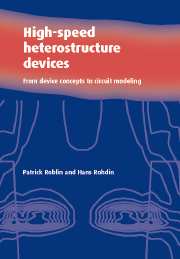Book contents
- Frontmatter
- Contents
- Preface
- Acknowledgements
- List of abbreviations
- Introduction
- 1 Heterostructure materials
- 2 Semiclassical theory of heterostructures
- 3 Quantum theory of heterostructures
- 4 Quantum heterostructure devices
- 5 Scattering processes in heterostructures
- 6 Scattering-assisted tunneling
- 7 Frequency response of quantum devices from DC to infrared
- 8 Charge control of the two-dimensional electron gas
- 9 High electric field transport
- 10 I – V model of the MODFET
- 11 Small- and large-signal AC models for the long-channel MODFET
- 12 Small- and large-signal AC models for the short-channel MODFET
- 13 DC and microwave electrothermal modeling of FETs
- 14 Analytical DC analysis of short-gate MODFETs
- 15 Small-signal AC analysis of the short-gate velocity-saturated MODFET
- 16 Gate resistance and the Schottky-barrier interface
- 17 MODFET high-frequency performance
- 18 Modeling high-performance HBTs
- 19 Practical high-frequency HBTs
- Index
1 - Heterostructure materials
Published online by Cambridge University Press: 06 July 2010
- Frontmatter
- Contents
- Preface
- Acknowledgements
- List of abbreviations
- Introduction
- 1 Heterostructure materials
- 2 Semiclassical theory of heterostructures
- 3 Quantum theory of heterostructures
- 4 Quantum heterostructure devices
- 5 Scattering processes in heterostructures
- 6 Scattering-assisted tunneling
- 7 Frequency response of quantum devices from DC to infrared
- 8 Charge control of the two-dimensional electron gas
- 9 High electric field transport
- 10 I – V model of the MODFET
- 11 Small- and large-signal AC models for the long-channel MODFET
- 12 Small- and large-signal AC models for the short-channel MODFET
- 13 DC and microwave electrothermal modeling of FETs
- 14 Analytical DC analysis of short-gate MODFETs
- 15 Small-signal AC analysis of the short-gate velocity-saturated MODFET
- 16 Gate resistance and the Schottky-barrier interface
- 17 MODFET high-frequency performance
- 18 Modeling high-performance HBTs
- 19 Practical high-frequency HBTs
- Index
Summary
It is as easy to count atomies, as to resolve the propositions of a lover.
As You Like It, William ShakespeareIntroduction
Modern growth technologies have made possible the growth of new semiconductor devices with unprecedented control on the atomic level. In this chapter we shall briefly introduce the molecular beam epitaxy (MBE) growth technique and discuss its application to the growth of materials (alloys, pseudomorphic, modulation doped) for new device structures. The chapter will conclude with a review of the cubic crystal structure and its reciprocal lattice, as these concepts are used extensively in Chapters 2 and 3.
MBE technology
One of the most versatile growth techniques available for research is the MBE. In this growth technique a semiconductor substrate is placed in a high-vacuum chamber (see Figure 1.1). Different components such as Ga, Al, As, In, P, and Si are heated in separate closed cylindrical cells. These components escape through an opening in the cylindrical cell and form a molecular beam. These beams are directed toward the substrate. A shutter positioned in front of each cell is used to select the desired molecular beams. By selecting a low temperature for the substrate growth and a slow growth rate (a few micrometers per hour), it is possible to grow high-quality crystals, while making abrupt changes in doping and crystal composition.
This growth technique can be used to grow semiconductor alloys such as AlxGa1–xAs, InxGa1–xAs, InxAl1–xAs, and Si1–xGex, where x, the mole fraction, specifies the composition of the alloy.
- Type
- Chapter
- Information
- High-Speed Heterostructure DevicesFrom Device Concepts to Circuit Modeling, pp. 1 - 18Publisher: Cambridge University PressPrint publication year: 2002
- 1
- Cited by

